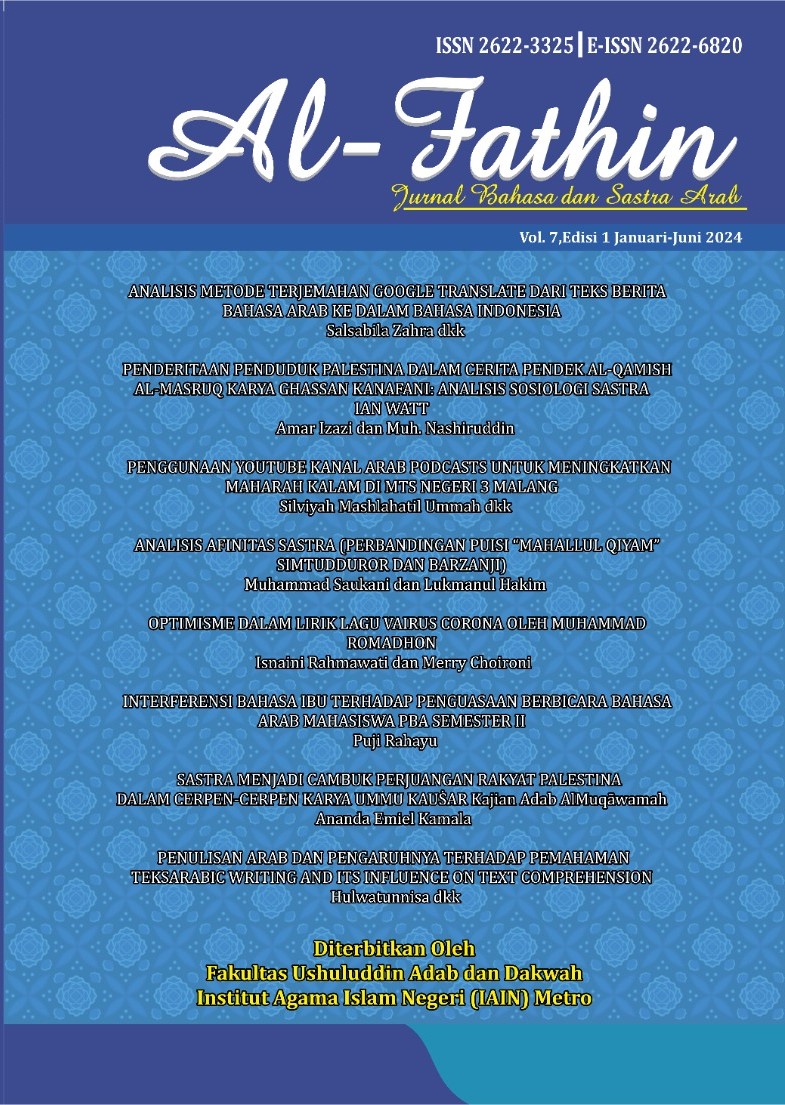Penulisan Arab dan Pengaruhnya terhadap Pemahaman Teks Arabic Writing and its Influence on text Comprehension
DOI:
https://doi.org/10.32332/al-fathin.v7i01.9446Kata Kunci:
Arabic, history, understanding, writingAbstrak
Arabic has its origins in the history of writing. This study aims to gather sufficient information about the history of Arabic writing and the influence of writing on the understanding of the writing. This research method is a literature study that collects some previous research to discuss the history of Arabic writing and answer what influence writing has on the understanding of the writing. The results showed that there are many opinions about the origin of the birth of Arabic script. At the time of the Prophet of Allah, the development of writing began in the 2nd year, the Prophet taught writing for prisoners who wanted to be released without having to pay a ransom. Arab society already has its own writing. Although still simple with a classical kufic form that does not have vowel markers and consonant differentiators. And also still do not know sentence markers such as dots, commas, or decorations in writing. So the arrival of the Qur'an made the development of Arabic writing better. Arabic writing is not free from mistakes. Errors in writing greatly affect reading comprehension, because even a single letter can change the meaning of reading. The comprehension of Arabic writing depends on knowledge of Arabic vocabulary and grammar.
Referensi
JurnalHumaniora. 2013.
Adūnīs. Arkeologi Sejarah Pemikiran Arab-Islam. LkiS Yogyakarta, 2012. https://www.google.co.id/books/edition/Arkeologi_Sejarah_Pemikiran_Arab_Islam_V/Q OlXDwAAQBAJ?hl=en&gbpv=0.
Agussalim, Andi, Yusring Sanusi B, Achmad Risky, Nur Putri, Widiyawati Nasir, Dzakiah Jilan, Andi Vieriawan, and Universitas Hasanuddin. “MENEMU-KENALI FAKTOR PENYEBAB KESALAHAN PENULISAN BAHASA ARAB DALAM TUGAS AKHIR MAHASISWA.” Jurnal Ilmu Budaya 11, no. 1 (2023): 45–55.
Anwar, Latifah. “Penulisan Hadis Pada Masa Rasulullah SAW.” Al-Bayan: Jurnal Ilmu Al-Qur’an Dan Hadist 3, no. 2 (2020): 131–56. https://doi.org/10.35132/albayan.v4i2.88.
Baso, Yusring Sanusi, Faridah Rahman, Haeruddin Haeruddin, and Najmuddin Abd Safa. “Hubungan Penguasaan Mufradat Dan Tingkat Pemahaman Membaca Teks Asli Bahasa Arab Mahasiswa.” Arabi : Journal of Arabic Studies 1, no. 2 (2016): 50. https://doi.org/10.24865/ajas.v1i2.12.
Ichsan.Muhammad. Sejarah Penulisan Dan Pemeliharaan Al-Qur’an Pada Masa Nabi Muhammad SAW Dan Sahabat. Jurnal Substantia 14, No. 1. April 2012.
Jawwad Ali. Sejarah Arab Sebelum Islam. Pustaka Alvabet, 2018. https://www.google.co.id/books/edition/Sejarah_Arab_Sebelum_Islam_Buku_1/0SRWDwAAQBAJ?hl=en&gbpv=1&dq=sejarah+penulisan+arab&pg=PA119&printsec=frontcov er.
Eliyana, Rizka. “Optimalisasi Keterampilan Menulis Arab Siswa Mi Menggunakan Media Strip Story.” Jurnal Ibriez : Jurnal Kependidikan Dasar Islam Berbasis Sains 8, no. 1 (2023): 35– 46.
G. Rex Smith John F. Healey. A Brief Introduction to The Arabic Alphabet (shaqi Books,2012),https://www.google.co.id/books/edition/A_Brief_Introduction_to_The_Ara bic_Alpha/fDohBQAAQBA?hl=en&gbpv=0. Di akses pada 12 Maret 2024
J.R. Osborn. Letters of Light Arabic Script in Calligraphy, Print, and Digital Design. Harvard University Press, 2017.
https://www.google.co.id/books/edition/Letters_of_Light/DFVavgAACAAJ?hl=en.
John F. Healey, G. Rex Smith. A Brief Introduction to The Arabic Alphabet. Saqi Books, 2012. https://www.google.co.id/books/edition/A_Brief_Introduction_to_The_Arabic_Alpha/fD ohBQAAQBAJ?hl=en&gbpv=0.
Kees Versteegh and Meikal Mumin. The Arabic Script in Africa Studies in the Use of a writingSystem(Brill,2014)https://www.google.co.id/books/edition/The_Arabic_Script_in_ Africa/7ALbAgAAQBAJ?hl=en&gbpv=0. Di akses pada 12 Maret 2024..
Khikmah, Nur. “Problematika Membaca Teks Arab Bagi Siswa Madrasah.” Alsina : Journal of Arabic Studies 1, no. 1 (2019): 47–66. https://doi.org/10.21580/alsina.1.1.3666.
Muhammad, Arsyad, Ali Ridho, Ahmad Dika Purnama, and Hafidz Shiddiq Hamonangan. “Urgensi Pembelajaran Bahasa Arab Sebagai Sarana Memahami Agama Islam Pada Ruang Lingkup Pendidikan Tinggi Islam.” ICONITIES (International Conference on Islamic Civilization and Humanities), 2023, 590–601.
Muḥammad Vaḥīd Mūsavī Jazāyirī, S. M. V. Mousavi Jazayeri, Perette E. Michelli, Saad D. Abulhab, Sayyid Muḥammad Ḥusayn Mūsavī Jazāyirī. A Handbook of Early Arabic Kufic Script Reading, Writing, Calligraphy, Typography, Monograms. Blautopf Publishing, 2017.
https://www.google.co.id/books/edition/A_Handbook_of_Early_Arabic_Kufic_Script/LCj5DQAAQBAJ?hl=en&gbpv=1&dq=history+of+Arabic+writing&printsec=frontcover.
Musri.Muhapril. Teks Klasik Dan Kaligrafi Islam. Indramayu: Penerbit Adab CV. Adanu Abimata.
2023.
Nabia Abbott. The Rise of the North Arabic Script and Its Kur’ānic Development. University of Chicago Press, 1939.
https://www.google.co.id/books/edition/The_Rise_of_the_North_Arabic_Script_and/rnxi AAAAMAAJ?hl=en&gbpv=0&bsq=The rise of the north Arabic.
Nafan Akhun. Linimasa & Sejarah Penulisan Kitab Suci; Perjanjian Lama, Perjanjian Baru Dan AlQuran Khulyan Publisher, 2021.
https://www.google.co.id/books/edition/Linimasa_Sejarah_Penulisan_Kitab_Suci_Pe/CvunEAAAQBAJ?hl=en&gbpv=1&dq=sejarah+penulisan+arab&pg=PT3&printsec=frontc over.
Nasir, Amin. “Bahasa Arab Era Klasik Dan Modern (Tinjauan Pembelajaran Teoritis).” Arabia 6, no. Januari (2014): 21–52.
Nasr.Seyyed Hossein, Islamic Art and Spiritually, Terjemah oleh (Bandung:Mizan,1933)..
Nasruddin. “Sejarah Penulisan Alquran (Kajian Antropologi Budaya).” Rihlah: Jurnal Sejarah Dan Kebudayaan II, no. 1 (2015): 53–68.
Nurjanah, Kiki. “Pengaruh Kemampuan Berbahasa Arab Dan Kemampuan Membaca Al-Qur’an Terhadap Hasil Belajar Al-Qur’an Hadist Kelas X Man 1 Bandar Lampung.” NBER Working Papers, 2023, 89. http://www.nber.org/papers/w16019.
Nurkholis. “Analisis Kesalahan Berbahasa Dalam Bahasa Arab.” Al-Fathin: Jurnal Bahasa Dan Sastra Arab 1, no. 01 (2018): 10. https://doi.org/10.32332/al-fathin.v1i01.1186.
Parhan, Parhan, Muhammad Abdul Jalil, Idrus Idrus, and Abdul Raup. “Peningkatan Pemahaman Teks Bahasa Arab Melalui Metode (SQ3R).” Ta’limi | Journal of Arabic Education and Arabic Studies 1, no. 1 (2022): 21–33. https://doi.org/10.53038/tlmi.v1i1.9.
Rafsanjani, Tuti, and Rhomiy Handican. “Systematic Literature Review : Pengaruh Bahasa Arab Terhadap Perkembangan Bahasa Indonesia.” AL-WARAQAH Jurnal Pendidikan Bahasa Arab 4, no. 1 (2023): 42–53. https://doi.org/10.30863/awrq.v4i1.3854.
Saidah, and Tawakkal. “Analisis Kesalahan Berbahasa Arab Dan Implikasinya Pada Makna.” Al- Gazali Journal of Islamic Education 1, no. 1 (2022): 4.
Salim, Latifah. “Sejarah Pertumbuhan Dan Perkembangan Sastra Arab.” Jurnal Diwan 4, no. 2 (2016): 77–90.
Sugiyono. Metode Penelitian. Bandung: Alfabeta, 2015.
Sukiman.Uki. Sastra Arab Awal Islam Masa Rasulullah SAW dan Al-khulafaAr-Rasyidun.
Yogyakarta: Idea press Yogyakarta. 2022.
Suryani, T. “Pengaruh Penguasan Sintaks Arab Terhadap Pemahaman Teks Bahasa Arab Pada Siswa MAN 2 Pesisir Selatan.” Journal of Educational Research and … 1, no. September (2023):1–11. https://pusdikrapublishing.com/index.php/jbhs/article/view/1495%0Ahttps://pusdikra- publishing.com/index.php/jbhs/article/download/1495/1327.
Tamrin. Dinamika Tulisan Arab. Al-Munir: JurnalIlmu Al-Qur’an dan Tafsir. Volume 2, No 2, juli- Desember 2020.
Versteegh, Kees, and Meikal Mumin. The Arabic Script in Africa Studies in the Use of a Writing System. Brill, 2014.
https://www.google.co.id/books/edition/The_Arabic_Script_in_Africa/7ALbAgAAQBAJ?hl=en&gbpv=0.










